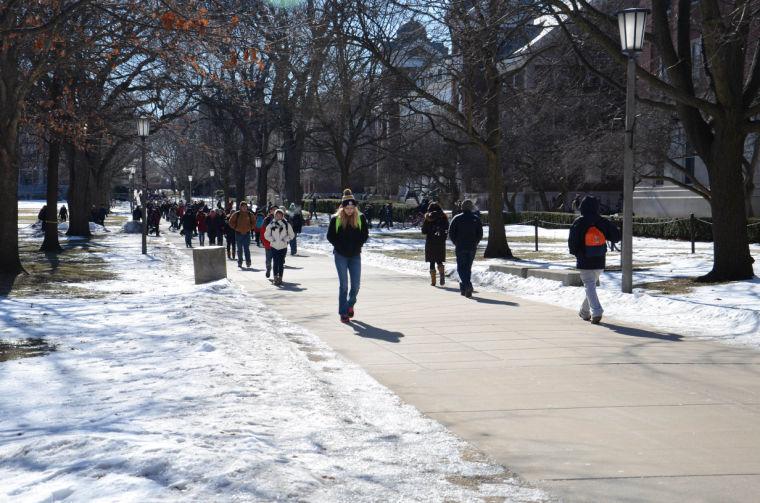Groundhogs’ spring predictions less accurate than chance
Students walk on the Quad all bundled up in order to fight the cold, on Tuesday, Jan. 28th in the afternoon.
Jan 30, 2014
Last updated on May 7, 2016 at 11:17 p.m.
With freezing temperatures and below-zero wind chills, the beginning of the spring semester has felt nothing like spring. Walking to class in these conditions can seem impossible, but some believe the end may be close with the upcoming holiday, Groundhog Day, on Sunday.
Groundhog Day originated as something similar to an Imbolc, a Celtic festival celebrating the beginning of spring. Imbolc later turned into a Christian feast called Candlemas. Those who observed the holiday thought that if it occurred on a sunny day, there would be 40 days left of winter. Similarly, in Germany, people determined whether or not the day was sunny if animals like badgers saw their shadow.
When Germans immigrated to America, many came to Pennsylvania, where they continued their tradition using the indigenous groundhog. It was in Punxsutawney, Penn., where the first Groundhog Day was celebrated on Feb. 2, 1887.
Each year, this celebration attracts thousands who gather together to see if groundhog Punxsutawney Phil sees his shadow. Phil has been prominent in U.S. culture with appearances on “The Oprah Winfrey Show” in 1995 and meeting politicians like President Ronald Reagan.
Get The Daily Illini in your inbox!
While Phil may arguably be the most acclaimed, there are other groundhogs who participate, such as Wiarton Willie of Canada and Staten Island Chuck of New York. This holiday has also gained popularity from the 1993 movie “Groundhog Day” starring Bill Murray.
Despite the day’s popularity, groundhogs have no weather predictive skills. According to the National Climatic Data Center, they have been right less than 40 percent of the time.
“I don’t believe (the groundhog’s prediction), but I like to see it,” said Mallory Meade, junior in LAS.
Daniel Chavez, sophomore in LAS, agreed, explaining that Groundhog Day is not grounded in science.
The same goes for Professor Eric Snodgrass, director of undergraduate studies in the department of atmospheric sciences.
“I imagine it’s like … you’re a detective, and you end up watching shows like ‘CSI: Miami,’ and you just watch and make fun of them because you know things don’t work that way. That’s kind of how a lot of us (meteorologists) feel about things like Groundhog Day. It’s a joke, but everyone gets a kick out of it,” Snodgrass said.
Snodgrass said there are a lot of different techniques to predict the upcoming spring season scientifically, but each technique has its limitations.
“The general rule of thumb is the longer the forecast time period, the greater the error,” Snodgrass said.
Analogous forecasts are one technique used to make seasonal predictions, Snodgrass explained. Meteorologists use weather data from past years to compare it to present conditions. For example, if one wants to know what February’s weather will be like, they can look at the weather from November, December and January and reference data to find a corresponding year that matched the weather of those three months. They can predict that the weather of that year’s February will match the upcoming February.
“These techniques … have skill but the accuracy of even a one-month, three-month or year-long forecast is you just can’t do it. The reason why is you are trying to predict the behavior of a nonlinear chaotic fluid,” Snodgrass said. “The atmosphere behaves like a fluid, and because of that, it is nearly impossible to predict its future beyond six or seven days.”
Regardless of the techniques used to predict spring, it is apparent that winter is prevalent in the Champaign-Urbana area. Temperatures reached a low of minus 2 degrees Fahrenheit with a wind chill of minus 18.1 degrees Fahrenheit on Monday.
“It was awful. I thought we might cancel (classes) because the public schools canceled,” Meade said.
Chavez said he is looking forward to spring so he can go outside more and not have to wear a jacket and sweater.
“I am desperately ready for spring,” Snodgrass said.
Whether the method is by science or by groundhogs, it seems only time can tell when spring will arrive.
Annabeth can be reached at [email protected].






